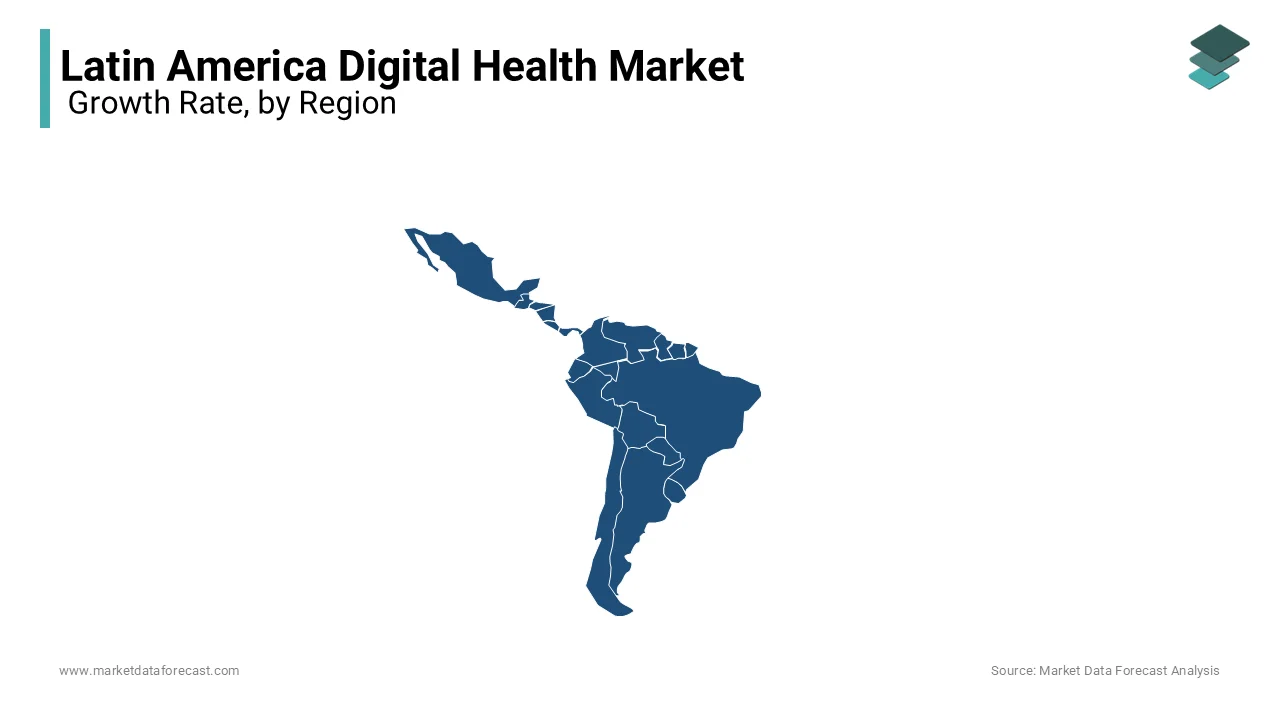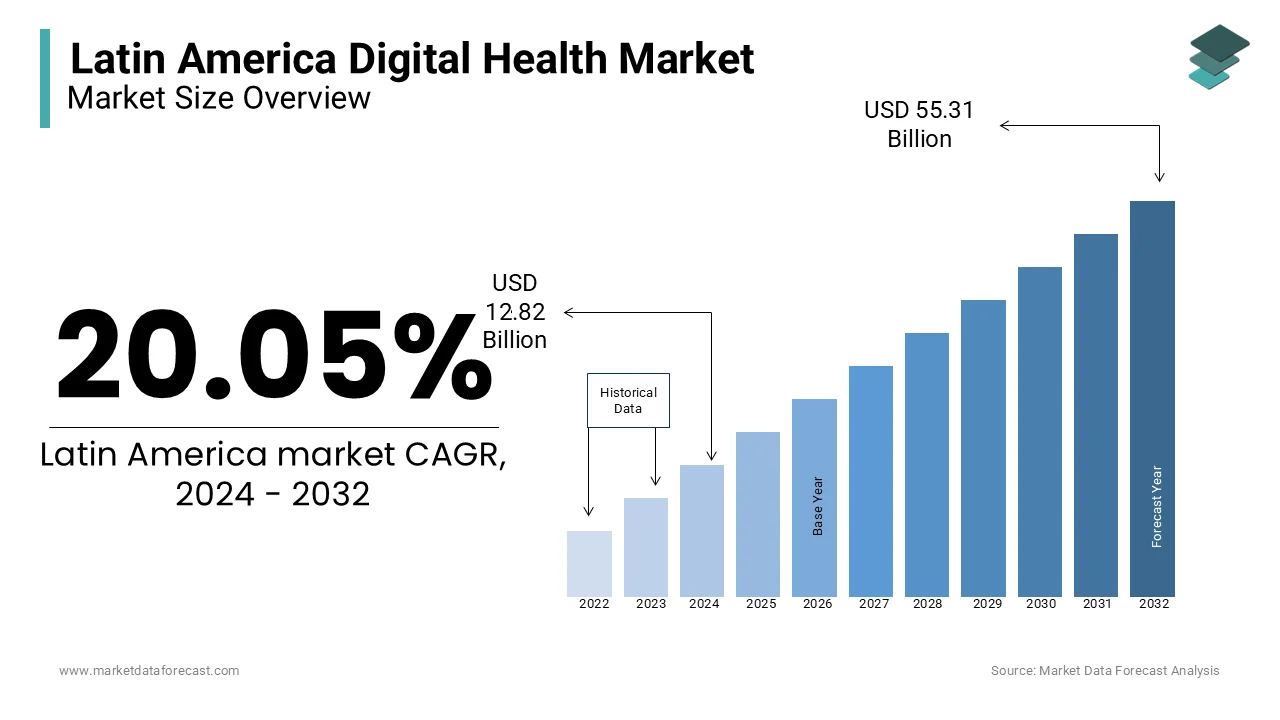Latin America Digital Health Market Research Report – Segmented By Technology, Component and Country (Brazil, Mexico, Argentina, Chile & Rest of Latin America) – Analysis on Size, Share, Trends, COVID-19 Impact and Growth Forecast (2024 to 2032)
Latin America Digital Health Market Size (2024 to 2032)
The size of the Latin America digital health market was valued at USD 10.68 billion in 2023. This market is expected to grow at a CAGR of 20.05% from 2024 to 2032 and be worth USD 55.31 billion by 2032 from USD 12.82 billion in 2024.
MARKET SCENARIO
The growing adoption of technology by the people in the healthcare system across the Latin American region is propelling market growth. The adoption of smartphones, laptops, PCs, and digital assistants has increased significantly in people's daily routines as these devices are the primary internet connectivity source in the region. The rising number of older adults across the region and the rising prevalence of chronic diseases in the region are demanding the usage of health apps, boosting Latin America's digital health market. There is growing awareness among people regarding the benefits of digital health as it consists of electronic health records, personalized medicine, and mobile health. Digital health helps in the daily monitoring of the patient's health condition through mobile health. Digital health is highly beneficial for people in remote areas, and it helps in doctor consultations. The increasing prevalence of chronic diseases like diabetes, cardiovascular diseases, cancer, and others requires long-term care and patient monitoring services where software is available, making it easy for the caretakers. These factors are propelling the growth of the market share of digital health in Latin America. Digital health services like online pharmacies, doctor consultations, and health and wellness coaching augment the regional market growth.
The growing technological advancements in the region's healthcare system are expected to drive the growth of Latin America's digital health market during the forecast period. By providing personalized treatment, remote monitoring services, and improving disease management, digital health is expected to revolutionize the healthcare system in the upcoming years. Increasing digital tools in the healthcare industry for diagnosis, treatment, and long-term care are creating opportunities for market growth. In the upcoming years, digital health is expected to drive the healthcare industry due to its various advantages and growing technology adoption among people.
Complete sensitive patient information is stored in the cloud-based system, where there is a high chance for data breaches and access to unauthorized personnel, hampering the region's market growth. There are a few cases of false information regarding health tracking, such as oxygen levels and blood pressure, which is expected to limit the market growth during the forecast period. The lack of internet access in remote areas and digital illiteracy from the uneconomic regions are limiting the implementation and utilization of digital health and hindering market expansion.
Privacy and security regarding patient-sensitive data are challenging for the Latin American digital health market as there is a requirement to increase security measures to avoid cyberattacks. The digital system can only be accurate in some cases where system errors may lead to loss of complete patient information, which is expected to limit market growth.
COVID-19 Impact on Latin America Digital Health Market
The pandemic positively impacted digital health as people adopted digital health due to lockdown regulations and hospital restrictions to meet their medical requirements. The pandemic influenced the healthcare industry to adopt digital health during the crisis. Telemedicine and the digital contact-tracing system for health emergencies have worked during the pandemic to support and improve health systems across the world. The post-pandemic is experiencing steady growth in digital health, which is expected to grow significantly over the forecast period.
SEGMENTAL ANALYSIS
Latin America Digital Health Market Analysis By Technology
- Tele-Healthcare
- Telecare
- Activity Monitoring
- Remote Medication Management
- Telehealth
- LTC Monitoring
- Video Consultation
- Telecare
- mHealth
- Wearables
- BP Monitor
- Glucose Meter
- Pulse Oximeter
- Sleep Apnea Monitors
- Neurological Monitors
- Others
- Apps
- Medical Apps
- Fitness Apps
- Wearables
- Health Analytics
- Digital Health Systems
- Electronic Health Records
- E-Prescribing Systems

The tele-healthcare segment dominated the Latin American digital health market in 2023 due to its prominent role during the Pandemic crisis. Telehealthier, cost-effective, quick, and accurate access to health services makes it easy for the future to meet patient requests. During the pandemic, telehealth has impacted people, who improved the consumer and provider attitude toward digital care, remote care, government policies, and innovation; all of these are driving the market growth in this segment.
The mHealth segment is projected to have the fastest growth during the forecast period due to the increasing adoption of wearables among people to maintain regular health tracking. The growing adoption of apps for medical advice and increasing awareness among people regarding fitness is expected to boost the market growth over the forecast period.
Latin America Digital Health Market Analysis By Component
- Hardware
- Software
- Service
The software segment dominated the regional market in 2023 due to its flexibility, cost-effectiveness, and high adoption among the people. Software is easy to use with innovation and improved healthcare delivery.
GEOGRAPHICAL ANALYSIS
- Brazil
- Mexico
- Argentina
- Chile
- Rest of Latin America

Brazil held the largest share of the Latin American regional market in 2023 and is expected to maintain domination during the forecast period. According to WHO records, over 70% of the Brazilian population has access to a digital health system due to rising mobile health solutions and high technology adoption. Digital wearables and apps are crucial in driving regional market growth.
Mexico held a prominent share of the regional market revenue. According to various reports, there is a vast range of innovations in the healthcare industry, mainly in the private sector. Most researchers and innovators in Mexico are utilizing technology, such as telemedicine, to increase the reach to patients more efficiently and enhance access to the healthcare system.
According to an article published in Soledad Munoz Lopez, the Chilean Ministry of Health explains that Chile is ready to adopt next-generation healthcare technology by applying machine learning to patient data or self-service capabilities delivered through wearable devices.
KEY MARKET PARTICIPANTS
Companies playing a leading role in the LATAM digital health market profiled in this report are Apple Inc., AirStrip Technologies, Google Inc., Orange, Allscripts Healthcare, LLC, Mckesson Corporation, Athenahealth Inc., At&T Inc., Biotelemetry, Inc., Cerner Corporation, Cisco Systems, Inc., Koninklijke Philips Nv, Eclinicalworks, Ihealth Lab, Inc. and General Electric Company.
Frequently Asked Questions
Which countries in Latin America contribute the most to the digital health market?
Brazil and Mexico are the leading contributors to the digital health market in Latin America, holding significant market shares.
What are the key trends shaping the digital health market in Latin America?
Latin America is witnessing a growing adoption of telehealth services and mobile health apps, driven by increased connectivity and smartphone penetration.
How does the digital health market in South America differ from the rest of the region?
Latin America exhibits a higher adoption rate of health information technologies, and countries like Argentina and Colombia are emerging as key players in the digital health sector.
Related Reports
Access the study in MULTIPLE FORMATS
Purchase options starting from $ 1600
Didn’t find what you’re looking for?
TALK TO OUR ANALYST TEAM
Need something within your budget?
NO WORRIES! WE GOT YOU COVERED!
Call us on: +1 888 702 9696 (U.S Toll Free)
Write to us: [email protected]

